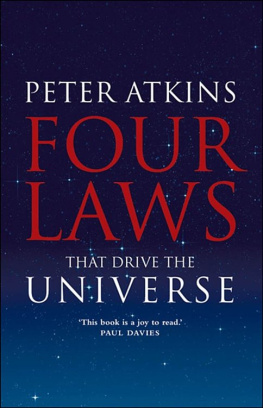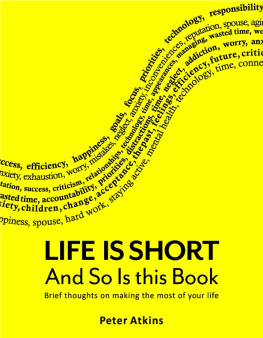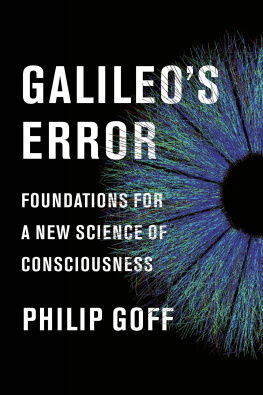Peter Atkins - Galileos Finger - The Ten Great Ideas of Science
Here you can read online Peter Atkins - Galileos Finger - The Ten Great Ideas of Science full text of the book (entire story) in english for free. Download pdf and epub, get meaning, cover and reviews about this ebook. year: 2003, publisher: OUP Oxford, genre: Romance novel. Description of the work, (preface) as well as reviews are available. Best literature library LitArk.com created for fans of good reading and offers a wide selection of genres:
Romance novel
Science fiction
Adventure
Detective
Science
History
Home and family
Prose
Art
Politics
Computer
Non-fiction
Religion
Business
Children
Humor
Choose a favorite category and find really read worthwhile books. Enjoy immersion in the world of imagination, feel the emotions of the characters or learn something new for yourself, make an fascinating discovery.

- Book:Galileos Finger - The Ten Great Ideas of Science
- Author:
- Publisher:OUP Oxford
- Genre:
- Year:2003
- Rating:5 / 5
- Favourites:Add to favourites
- Your mark:
- 100
- 1
- 2
- 3
- 4
- 5
Galileos Finger - The Ten Great Ideas of Science: summary, description and annotation
We offer to read an annotation, description, summary or preface (depends on what the author of the book "Galileos Finger - The Ten Great Ideas of Science" wrote himself). If you haven't found the necessary information about the book — write in the comments, we will try to find it.
Galileos Finger - The Ten Great Ideas of Science — read online for free the complete book (whole text) full work
Below is the text of the book, divided by pages. System saving the place of the last page read, allows you to conveniently read the book "Galileos Finger - The Ten Great Ideas of Science" online for free, without having to search again every time where you left off. Put a bookmark, and you can go to the page where you finished reading at any time.
Font size:
Interval:
Bookmark:
GALILEOS FINGER
PROLOGUE
The Emergence of Understanding
ONE
EVOLUTION
The Emergence of Complexity
TWO
DNA
The Rationalization of Biology
THREE
ENERGY
The Universalization of Accountancy
FOUR
ENTROPY
The Spring of Change
FIVE
ATOMS
The Reduction of Matter
SIX
SYMMETRY
The Quantification of Beauty
SEVEN
QUANTA
The Simplification of Understanding
EIGHT
COSMOLOGY
The Globalization of Reality
NINE
SPACETIME
The Arena of Action
TEN
ARITHMETIC
The Limits of Reason
EPILOGUE
The Future of Understanding

The middle finger of Galileos right hand.
The finger was detached from Galileos body on 12 March 1737 when his remains were transferred to the main body of the church of Santa Croce, Florence. It is currently in the Museo di Storia della Scienza. The vessel that contains the finger has a cylindrical alabaster base, with the following description:
Leipsana ne spernas digiti, quo dextera coeli
Mensa vias, nunquam visos mortalibus orbes
Monstravit, parvo fragilis molimine vitri
Ausa prior facinus, cui non Titania quondam
Sufficit pubes congestis montibus altis,
Nequidquam superas conata ascendere in arces.
Do not look down upon the relic of a finger, by means of which a right hand measured paths in the heavens and revealed to mortals celestial bodies never seen. By preparing a small piece of fragile glass it first dared a feat which long ago was beyond the powers of young Titans, who piled mountains high in a vain attempt to ascend to lofty citadels.
The Ten Great Ideas of Science
PETER ATKINS


Great Clarendon Street, Oxford OX2 6DP
Oxford University Press is a department of the University of Oxford.
It furthers the Universitys objective of excellence in research, scholarship,
and education by publishing worldwide in
Oxford New York
Auckland Bangkok Buenos Aires Cape Town Chennai
Dar es Salaam Delhi Hong Kong Istanbul Karachi Kolkata
Kuala Lumpur Madrid Melbourne Mexico City Mumbai Nairobi
Sao Paulo Shanghai Singapore Taipei Tokyo Toronto
Oxford is a registered trade mark of Oxford University Press
in the UK and in certain other countries
Published in the United States
by Oxford University Press Inc., New York
Peter Atkins, 2003
The moral rights of the author have been asserted
Database right Oxford University Press (maker)
First published 2003
All rights reserved. No part of this publication may be reproduced,
stored in a retrieval system, or transmitted, in any form or by any means,
without the prior permission in writing of Oxford University Press,
or as expressly permitted by law, or under terms agreed with the appropriate
reprographics rights organization. Enquiries concerning reproduction
outside the scope of the above should be sent to the Rights Department,
Oxford University Press, at the address above
You must not circulate this book in any other binding or cover
and you must impose this same condition on any acquirer
British Library Cataloguing in Publication Data
Data available
Library of Congress Cataloging in Publication Data
Data available
ISBN 0 19 860664 8 (hb)
10 9 8 7 6 5 4 3 2 1
Designed & typeset by Pete Russell, Faringdon, Oxon
Printed in Great Britain
on acid-free paper by T. J. International Limited, Padstow, Cornwall
THE EMERGENCE OF UNDERSTANDING
WHY HIS FINGER? Galileo marks the turning point, when the scientific endeavour took a new direction, when scientistsan anachronistic term at the time, of courserose from their armchairs, questioned the efficacy of the preceding attempts to come to grips with the nature of the world by thought in alliance with authority, and took the first faltering steps down the path of modern science. In the process they rejected untested authority, and while not letting go entirely of armchair speculation and inner contemplation, forged a new, more powerful alliance with the technique of publicly verifiable experimental observation. We see this aspect of Galileos finger dabbling in all our current scientific pies. We see it in physics, where it first began to stir; in chemistry, where it found its way at the beginning of the nineteenth century; and in biology, especially since biology ceased being merely a source of wonder during the nineteenth and twentieth centuries.
In short, this book celebrates the effectiveness of Galileos symbolic finger for the winkling out of truth. That only Galileos physical finger is preserved but the descendants of his techniques thrive is also symbolic of the transitoriness of personal existence in contrast to the immortality of knowledge. Galileos finger, then, represents that misty concept the scientific method. He was not alone, of course, or first, in introducing this approach to the discovery of knowledge, but he is sufficiently prominent in the history of ideas for it to be reasonable to adopt him as a symbol of its introduction. One aspect of this amazingly potent method for disinterring truth about the world that distinguishes science from its principal rivalnamely, impressively expressed but ultimately idle speculationis the centrality of experiment. Going out into the world and making observations under carefully controlled conditions minimizes the subjective component of our perception and, in principle, opens up the observations to public scrutiny.
Galileo also developed the art of simplification, the isolation of the essentials of a problem, the peering in his thoughts through the clouds that in real systems conceal the underlying simplicity, just as he looked through his actual telescope and saw the complexity of the heavens. He set aside the creaking cart pulled through mud; instead, he considered the simplicity of a ball rolling on an inclined plane, a pendulum swinging from a high support. That isolation of the core phenomenon from the creaks and confusions of reality is a key part of the scientific method. Scientists see the pearl in the oyster, the jewel in the crown.
Some, of course, will claim that here lies weakness. True understanding, they claim, comes from appreciating the hurly-burly of reality: the cart bogged down, the lover lamenting, the lark ascending. That scientists examine a butterfly to study its mechanism is an abnegation of understanding, they claim. We have to see this objection in perspective, not reject it out of hand. Most scientists, being human, accept that sentiment is a wonderful component of our interaction with the world, but few would accept that it is a reliable route to truth. They prefer to disentangle the awesome complexity of the world, examine it piece by isolated piece, and build it up again, with deeper understanding, as best they can. They study the behaviour of a ball on an inclined plane in order to understand the cart on the hill; they study the pendulum in order to understand the swing of the athletes leg. Their opponents will cry that understanding the physics of vibration does not illuminate the joy of music and that picking apart a symphony into a bag of notes destroys our understanding of its composition. The scientist replies that we must first understand what it is to be a note, then move on to understand why it is that some chords are agreeable and others dissonant, and thenmaybe not for decadestry to understand the psychological and artistic impact of a sequence of chords. Science aims for thoroughness of understanding, never losing sight of the ultimate goal and not rushing to it impatiently half-baked. Whether scientists will ever comprehend our joy of comprehending the world, of acting out our lives within it, and all the other great questions that philosophers, artists, prophets, and theologians consider to be their territory of discourse is a matter for idle speculation. And we all know how useful that has been.
Next pageFont size:
Interval:
Bookmark:
Similar books «Galileos Finger - The Ten Great Ideas of Science»
Look at similar books to Galileos Finger - The Ten Great Ideas of Science. We have selected literature similar in name and meaning in the hope of providing readers with more options to find new, interesting, not yet read works.
Discussion, reviews of the book Galileos Finger - The Ten Great Ideas of Science and just readers' own opinions. Leave your comments, write what you think about the work, its meaning or the main characters. Specify what exactly you liked and what you didn't like, and why you think so.












